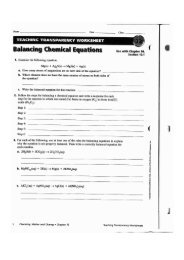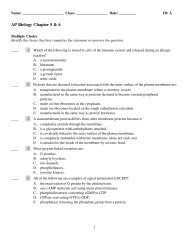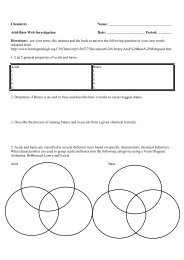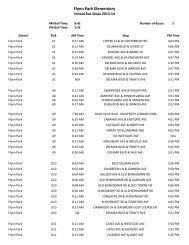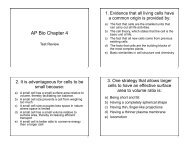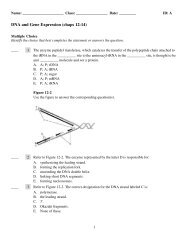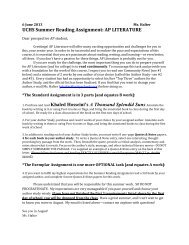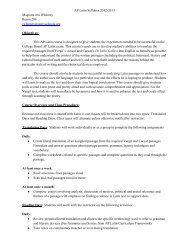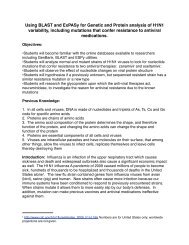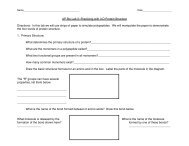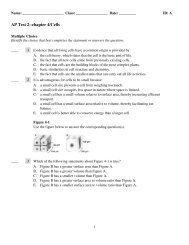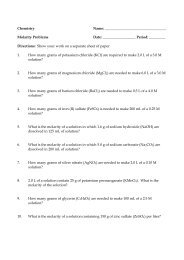How Cells make ATP: Energy-Releasing Pathways - University City ...
How Cells make ATP: Energy-Releasing Pathways - University City ...
How Cells make ATP: Energy-Releasing Pathways - University City ...
You also want an ePaper? Increase the reach of your titles
YUMPU automatically turns print PDFs into web optimized ePapers that Google loves.
Aerobic Respiration<strong>How</strong> <strong>Cells</strong> <strong>make</strong> <strong>ATP</strong>:<strong>Energy</strong>-<strong>Releasing</strong> <strong>Pathways</strong>Chapter 8• A catabolic process• fuel (glucose) broken down to carbon dioxideand water• Redox reactions• transfer electrons from glucose (oxidized)• to oxygen (reduced)• <strong>Energy</strong> released• produces 36 to 38 <strong>ATP</strong> per glucoseLearning Objective 1• In aerobic respiration, which reactant isoxidized and which is reduced?C 6 H 12 O 6 + 6O 2 ! 6CO 2 + 6 H 2 O + energyAerobic respiration is an exergonic redoxprocess in which glucose becomesoxidized, oxygen becomes reduced, andenergy is captured to <strong>make</strong> <strong>ATP</strong>1. Glycolysis4 Stages ofAerobic Respiration2. Formation of acetyl CoA3. Citric acid cycle4. Electron transport chain andchemiosmosisGlycolysis• 1 molecule of glucose degraded• to 2 molecules pyruvate• 2 <strong>ATP</strong> molecules (net) produced• by substrate-level phosphorylation• 4 hydrogen atoms removed• to produce 2 NADHGLYCOLYSIS<strong>Energy</strong> investment phase and splittingof glucoseTwo <strong>ATP</strong>s invested per glucose3stepsGlucose2 <strong>ATP</strong>2 ADPFructose-1,6-bisphosphatePPGlyceraldehydephosphate(G3P)PGlyceraldehydephosphate(G3P)PFig. 8-3, p. 175
<strong>Energy</strong> capture phaseFour <strong>ATP</strong>s and two NADHproduced per glucoseNAD +NADH2 ADP2 <strong>ATP</strong>(G3P)P5steps(G3P)PNAD+NADH2 ADP2 <strong>ATP</strong>Formation of Acetyl CoA• 1 pyruvate molecule• loses 1 molecule of carbon dioxide• Acetyl group + coenzyme A• produce acetyl CoA• 1 NADH produced per pyruvatePyruvatePyruvateNet yield per glucose:Two <strong>ATP</strong>s and two NADHFig. 8-3, p. 175Citric Acid CycleNAD +NADHCarbondioxidePyruvateCO 2Coenzyme A• 1 acetyl CoA enters cycle• combines with 4-C oxaloacetate• forms 6-C citrate• 2 C enter as acetyl CoA• 2 leave as CO 2• 1 acetyl CoA• transfers H atoms to 3 NAD + , 1 FAD• 1 <strong>ATP</strong> producedAcetyl coenzyme AFig. 8-5, p. 178Acetyl coenzyme ACoenzyme AElectron Transport ChainNADHNAD +H 2 OFADH 2OxaloacetateFADC I T R I CA C I DC Y C L ECitrateNAD +NADHCO 25-carbon compound• H atoms (or electrons) transfer• from one electron acceptor to another• in mitochondrial inner membrane• Electrons reduce molecular oxygen• forming waterADPGTPGDP<strong>ATP</strong>4-carbon compoundCO 2NADHFig. 8-6, p. 179
Oxidative PhosphorylationCytosolOuter mitochondrialmembraneIntermembranespace• Redox reactions in ETC are coupled to<strong>ATP</strong> synthesis through chemiosmosisComplex I: NADH–Inner ubiquinonemitochondrial oxidoreductasemembraneComplex II:Succinate–ubiquinonereductaseComplex III:Ubiquinone–cytochrome coxidoreductaseComplex IV:Cytochrome coxidaseMatrix ofmitochondrion FADH 2FAD 2 H + H 2 ONADHNAD + 1 / 2 O 2Fig. 8-8, p. 181<strong>Energy</strong> Capture1 2 3 4GlycolysisGlucoseFormation ofacetylcoenzyme ACitric acidcycleElectrontransport andchemiosmosisPyruvateAcetylcoenzymeAMitochondrionCitricacidcycleElectrontransport andchemiosmosis2 <strong>ATP</strong> 2 <strong>ATP</strong> 32 <strong>ATP</strong>• Glycolysis• 1 glucose: 2 NADH, 2 <strong>ATP</strong> (net)• Conversion of 2 pyruvates to acetyl CoA• 2 NADH• Citric acid cycle• 2 acetyl CoA: 6 NADH, 2 FADH 2 , 2 <strong>ATP</strong>• Total: 4 <strong>ATP</strong>, 10 NADH, 2 FADH 2Fig. 8-2, p. 173<strong>Energy</strong> Transfer• Electron transport chain (ETC)• 10 NADH and 2 FADH 2 produce 32 to 34 <strong>ATP</strong>by chemiosmosis• 1 glucose molecule yields 36 to 38 <strong>ATP</strong>Substrate-levelphosphorylation Glycolysis OxidativephosphorylationGlucosePyruvateAcetylcoenzymeACitricacidcycleTotal <strong>ATP</strong> fromsubstrate-levelphosphorylationTotal <strong>ATP</strong> fromoxidativephosphorylationFig. 8-11, p. 185
Learning Objective 5• Define chemiosmosis• <strong>How</strong> is a gradient of protons establishedacross the inner mitochondrial membrane?Chemiosmosis• <strong>Energy</strong> of electrons in ETC• pumps H + across inner mitochondrialmembrane• into intermembrane space• Protons (H + ) accumulate in intermembranespace• lowering pH<strong>ATP</strong> SynthaseOuter mitochondrialmembraneCytosolInner mitochondrialmembrane• Enzyme <strong>ATP</strong> synthase• forms channels through inner mitochondrialmembrane• Diffusion of protons through channelsprovides energy to synthesize <strong>ATP</strong>Intermembranespace — low pHMatrix — higher pHFig. 8-9, p. 183CytosolOutermitochondrialmembraneIntermembranespaceKEY CONCEPTSInnermitochondrialmembraneMatrix ofmitochondrionNADHComplex INAD +ComplexIIFADH 2ComplexIII12ComplexIVComplex V:<strong>ATP</strong>synthase• Nutrients other than glucose, includingmany carbohydrates, lipids, and aminoacids, can be oxidized by aerobicrespirationADP P i<strong>ATP</strong>Fig. 8-10a, p. 184
Amino Acids• Undergo deamination• Carbon skeletons converted• to intermediates of aerobic respiration•Lipids• Glycerol and fatty acids• both oxidized as fuel• Fatty acids• converted to acetyl CoA by !-oxidationPROTEINS CARBOHYDRATESAminoacidsFATSGlycolysisGlycerolFattyacidsGlucoseG3PPyruvateCO 2AcetylcoenzymeACitricacidcycleElectrontransport andchemiosmosisEndproducts: NH 3H 2 O CO 2Fig. 8-12, p. 186Anaerobic Respiration• Electrons transferred• from fuel molecules to ETC• coupled to <strong>ATP</strong> synthesis (chemiosmosis)• Final electron acceptor• inorganic substance• nitrate or sulfate (not molecular oxygen)KEY CONCEPTS• In anaerobic respiration carried out bysome bacteria, <strong>ATP</strong> is formed during aredox process in which glucose becomesoxidized and an inorganic substancebecomes reduced• Anaerobic process• no ETCFermentation• Net energy gain only 2 <strong>ATP</strong> per glucose• produced by substrate-level phosphorylationduring glycolysis• NAD +• produced by transferring H from NADH toorganic compound from nutrientFermentation• Alcohol fermentation• in yeast cells• waste products: ethyl alcohol, CO2• Lactate (lactic acid) fermentation• some fungi, prokaryotes, animal cells• H atoms added to pyruvate• waste product: lactate
GlycolysisKEY CONCEPTSGlucose2 NAD + 2 NADH• Fermentation is an inefficient anaerobicredox process in which glucose becomesoxidized and an organic substancebecomes reduced• Some fungi and bacteria, as well asmuscle cells under conditions of lowoxygen, obtain low yields of <strong>ATP</strong> throughfermentation2 <strong>ATP</strong>CO 22 Pyruvate2 Ethyl alcohol(b) Alcohol fermentationFig. 8-13b, p. 187GlycolysisGlucose2 NAD + 2 NADHSummary Reaction• Complete oxidation of glucose2 <strong>ATP</strong>2 PyruvateC 6 H 12 O 6 + 6 O 2 + 6 H 2 O !6 CO 2 + 12 H 2 O + energy (36 to 38 <strong>ATP</strong>)2 Lactate(c) Lactate fermentationFig. 8-13c, p. 187Summary Reaction• GlycolysisC 6 H 12 O 6 + 2 <strong>ATP</strong> + 2 ADP + 2 P i + 2 NAD +! 2 pyruvate + 4 <strong>ATP</strong> + 2 NADH + H 2 O• Conversion of pyruvate to acetyl CoA2 pyruvate + 2 coenzyme A + 2 NAD + !2 acetyl CoA + 2 CO 2 + 2 NADHSummary Reaction• Citric acid cycle2 acetyl CoA + 6 NAD + + 2 FAD + 2 ADP+ 2 P i + 2 H 2 O ! 4 CO 2 + 6 NADH +2 FADH 2 + 2 <strong>ATP</strong> + 2 CoA• Hydrogen atoms in ETCNADH + 3 ADP + 3 P i + 12 O 2 ! NAD + + 3<strong>ATP</strong> + H 2 OFADH 2 + 2 ADP + 2 P i + 12 O 2 ! FAD + 2<strong>ATP</strong> + H 2 O
Summary Reaction• Lactate fermentationC 6 H 12 O 6 ! 2 lactate + energy (2 <strong>ATP</strong>)•Alcohol fermentationC 6 H 12 O 6 ! 2 CO 2 + 2 ethyl alcohol +energy (2 <strong>ATP</strong>)



